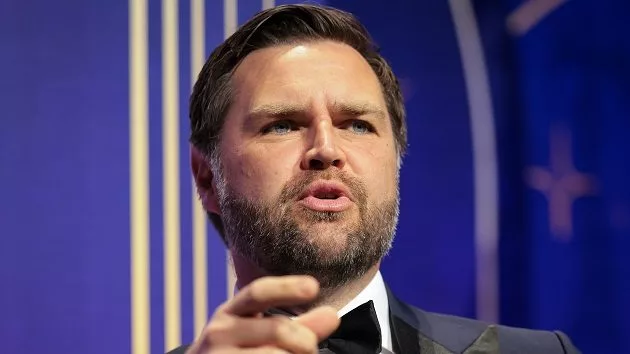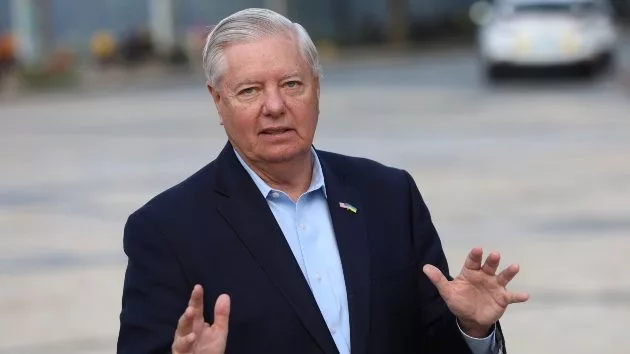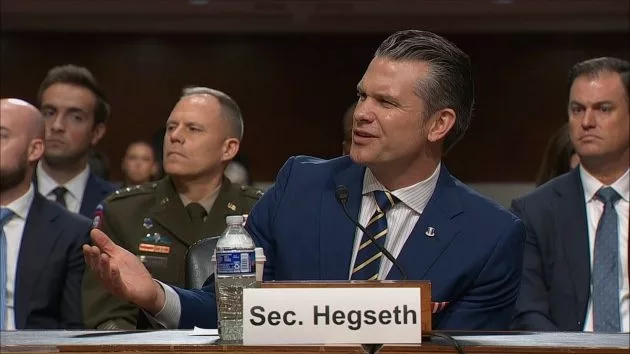(WASHINGTON) — By the time President Donald Trump and MAGA podcaster Steve Bannon sat down for lunch on Thursday, the president had already approved a plan on how the U.S. might attack an Iranian nuclear facility.
American diplomats and their family members were being offered military evacuations from Israel, while the military began moving aircraft and ships to the region.
The USS Nimitz – an aircraft carrier that can carry some 60 fighter jets – was set to arrive in the Middle East by the weekend with several smaller ships by its side.
Officials said the extraordinary show of force would be needed if Trump pulled the trigger on the military option – both to strike Iran’s deeply buried nuclear facility and to protect the some 40,000 U.S. troops who Iran and proxy militant groups could target for retaliation.
Trump had just emerged from a meeting with advisers in the Oval Office, where sources say he was warned: A U.S. attack on a key Iranian nuclear facility could be risky, even with a massive “bunker-buster” bomb believed to be able to penetrate some 200 feet through hardened earth.
The bomb, known as the Massive Ordnance Penetrator, had only been tested, but never used in a real-life tactical situation, experts say. And the exact nature of the concrete and metal protecting the Iranian nuclear site known as Fordo isn’t known, introducing the chance that a US strike would poke a hornet’s nest without destroying it.
Bannon, who had already spoken with the president by phone ahead of their lunch, thought all of it was a bad idea, according to several people close to him.
Sources say he arrived at the White House for his previously scheduled lunch with Trump armed with specific talking points: Israeli intelligence can’t be trusted, he planned to say, and the bunker-buster bomb might not work as planned. The precise risk to the U.S. troops in the Middle East, particularly the 2,500 in Iraq, also wasn’t clear if Iran retaliated, he would add.
A White House official insists that by the time Trump sat down with Bannon for lunch the president had already made a decision to hold off on a strike against Iran. That decision was relayed to White House Press Secretary Karoline Leavitt who then went to the podium, telling reporters the president would decide “whether or not to go” within two weeks.
Another senior administration official dismissed the idea that the “bunker-buster” bomb might not work.
“This Administration is supremely confident in its abilities to dismantle Iran’s nuclear program. No one should doubt what the U.S. military is capable of doing,” the official said.
Still, Bannon’s extraordinary access to Trump this week to discuss a major foreign policy decision like Iran is notable considering Bannon holds no official role in the military or at the State Department. Bannon declined to comment on his lunch with Trump, saying only Israeli Prime Minister Benjamin Netanyahu “needs to finish what they started.”
“Bannon in a lot of ways has been – day in and day out – delivering a very, very tough and clear message” against military action, said Curt Mills, executive director of The American Conservative, who also opposes military action in Iran.
That strategy, Mills said, has been key to countering other Trump loyalists who favor teaming up with Israel for a strike.
“You can call it infantile. You can call it democratic, or both,” Mills told ABC News. “This is a White House that is responding in real time to its coalition [which is] revolting to show it’s disgusted with the potential of war with Iran.”
At odds with Bannon’s viewpoint on Iran are other influential conservatives.
“Be all in, President Trump, in helping Israel eliminate the nuclear threat,” Sen. Lindsey Graham, R-South Carolina, told Fox News host Sean Hannity this week. “If we need to provide bombs to Israel, provide bombs. If we need to fly planes with Israel, do joint operations.”
According to one U.S. official, Defense Secretary Pete Hegseth mostly ceded the discussion to military commanders, including Gen. Erik Kurilla, commander of military forces in the Mideast, and Gen. Dan Caine, chairman of the Joint Chiefs of Staff, who have spent considerable time talking with Trump by phone and in person in recent weeks about his options with Iran and the risks involved, which can be extraordinarily complicated.
“Anybody will tell you the biggest threat to the region is a nuclear-armed Iran,” the official said. “No one wants Iran to have a nuke.”
Sean Parnell, chief Pentagon spokesperson, pushed back on the suggestion Hegseth hasn’t taken a lead role in the talks, calling it “completely false.” He said Hegseth speaks with Trump “multiple times a day each day,” and attended meetings with the president in the Situation Room.
“Secretary Hegseth is providing the leadership the Department of Defense and our Armed Forces need, and he will continue to work diligently in support of President Trump’s peace through strength agenda,” Parnell said.
Sources say Secretary of State Marco Rubio, who is also the president’s interim national security adviser, has been another constant presence at the president’s side during the discussions along with Trump’s Mideast adviser Steve Witkoff.
Once seen as one of Trump’s most hawkish cabinet members, Rubio espoused a hardline stance on Iran for years and warned last month that the country was now “a threshold nuclear weapons state.”
But since then, sources say, Rubio has become much more closely aligned with MAGA’s “America First,” noninterventionist stance, adding that he is acutely aware of the political repercussions that a direct attack on Iran could bring about.
U.S. and Israeli intelligence agree that Iran has been enriching uranium to a dangerously high concentration and could quickly amass enough of it to build several nuclear weapons.
But U.S. intelligence also cautions that its supreme leader, Ayatollah Ali Khamenei, hasn’t given the order to build those devices. The question now is how soon Iran could declare itself a nuclear power after that decision was made.
The uncertainty has drawn comparisons in MAGA circles to faulty intelligence in Iraq, which supporters of the movement blame for the lengthy war.
Tulsi Gabbard, Trump’s director of national intelligence, who has warned on social media of “warmongers,” told Congress this spring that “Iran is not building a nuclear weapon.” When asked Friday about that assessment, Trump responded that the intelligence community “is wrong” and “she’s wrong.” Gabbard later said her testimony was being taken out of context.
“America has intelligence that Iran is at the point that it can produce a nuclear weapon within weeks to months, if they decide to finalize the assembly. President Trump has been clear that can’t happen, and I agree,” she wrote in a post on Friday.
Sources say another factor could have played a role in Trump’s decision to hold off on striking Iran for now despite his insistence that Iran was close to a nuclear bomb. A third aircraft carrier, the USS Gerald R. Ford and its guided-missile destroyers are set to deploy early next week to head toward Europe, according to the Navy.
The carrier strike group needs time to travel before it could be in a position to help protect troops in theater should Trump opt to move ahead with the strike two weeks from now.
Officials caution that any success Bannon might have in pulling the president back from the brink of war could be brief. When asked on Friday by reporters if he would ask Israel to stop bombing Iran to enable diplomatic negotiations, Trump said probably not.
“If someone is winning, it’s a little bit harder to do than if someone is losing,” Trump said of the Israelis.
“But we’re ready, willing and able and have been speaking to Iran and we’ll see what happens. We’ll see what happens.”
ABC News’ Beatrice Peterson contributed to this report.
Editor’s note: This story has been corrected to reflect that Thursday’s meeting took place in the Oval Office, not the Situation Room.
Copyright © 2025, ABC Audio. All rights reserved.





